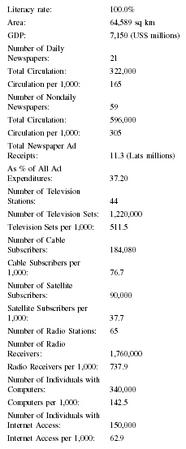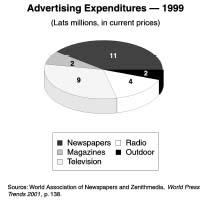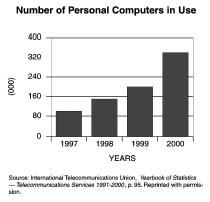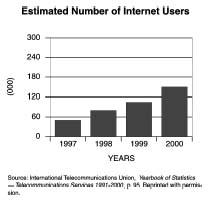Latvia
Basic Data

| Official Country Name: | Republic of Latvia |
| Region (Map name): | Europe |
| Population: | 2,385,231 |
| Language(s): | Latvian or Lettish, Luithuanian, Russian |

| Literacy rate: | 100.0% |
| Area: | 64,589 sq km |
| GDP: | 7,150 (US$ millions) |
| Number of Daily Newspapers: | 21 |
| Total Circulation: | 322,000 |
| Circulation per 1,000: | 165 |
| Number of Nondaily Newspapers: | 59 |
| Total Circulation: | 596,000 |
| Circulation per 1,000: | 305 |
| Total Newspaper Ad Receipts: | 11.3 (Lats millions) |
| As % of All Ad Expenditures: | 37.20 |
| Number of Television Stations: | 44 |
| Number of Television Sets: | 1,220,000 |
| Television Sets per 1,000: | 511.5 |
| Number of Cable Subscribers: | 184,080 |
| Cable Subscribers per 1,000: | 76.7 |
| Number of Satellite Subscribers: | 90,000 |
| Satellite Subscribers per 1,000: | 37.7 |
| Number of Radio Stations: | 65 |
| Number of Radio Receivers: | 1,760,000 |
| Radio Receivers per 1,000: | 737.9 |
| Number of Individuals with Computers: | 340,000 |
| Computers per 1,000: | 142.5 |
| Number of Individuals with Internet Access: | 150,000 |
| Internet Access per 1,000: | 62.9 |
Background & General Characteristics
Most newspapers in Latvia are less than a decade old, although the first newspaper in Latvian appeared in 1822. Since becoming an independent country, Latvian media enjoys greater freedom than ever before in its history. The government generally respects freedom of speech and expression. As Latvia works to transform its economic and political systems, the major barriers to a free society and independent media are largely of a financial nature. Although newspaper circulation figures are typically small in Latvia, the industry can be characterized as an active one that enjoys a large measure of constitutionally guaranteed freedom. Most press activity occurs in the more populous western region of the country, particularly in the capital of Riga.
The Latvian newspaper market has only existed in its present state for the last decade, since independence in 1991. Until the end of the Soviet period, it was not possible to speak of free, democratic media in Latvia. Beginning in 1985, Gorbachev's policy of glasnost gave newspaper and magazine editors in Latvia and other republics of the Soviet Union some opportunities to publish information on a wider range of formerly proscribed subjects, including crime, illegal drugs, occupational injuries, and environmental issues. An article published in October 1986 in the Latvian literary journal Literatura un Maksla, discussing the environmental impact of a new hydroelectric station that was to be built on the Daugava River, helped to arouse so much public opposition that a decision was made by the Soviet government in 1987 to abandon the project. Subsequently, after the pivotal June 1988 plenum of the Latvian Writers Union, the speeches delivered at this plenum denouncing the Soviet Latvian status quo and demanding greater autonomy for the Latvian republic received nationwide attention when they were published in four successive issues of Literatura un Maksla.
After a brief period of independence between the two World Wars, Latvia was annexed by the USSR in 1940. It reestablished its independence in 1991 following the breakup of the Soviet Union. Although the last Russian troops left in 1994, the status of the Russian minority (some 30 percent of the population) remains of concern to Moscow. Latvia continues to revamp its economy for eventual integration into various Western European political and economic institutions.
Latvian is the official language, however, Russian is spoken by a large number of individuals. The main ethnic groups are Latvian, 56.5 percent; Russian, 30.4 percent; Belarusian, 4.3 percent; Ukrainian, 2.8 percent; Polish, 2.6 percent; and others, 3.4 percent. Ethnic tensions between the non-Slavic majority and the large Russian minority are clearly reflected in the media. The conflict between the two languages stems from more than 50 years of ethnic tension between the republic's Russian and Latvian populations. In 1940, Soviet leader Joseph Stalin moved thousands of Russians into Latvia to gain ethnic control over the region. Although ethnic Latvians

Latvia is located in Eastern Europe, bordering the Baltic Sea, between Estonia and Lithuania. On the east it borders Belarus and Russia. The country is slightly larger than West Virginia, and has a population of 2.4 million. Riga is the capital and by far largest city with approximately 795,000 residents.
In 1997 Latvia was the home of 229 newspapers, with total newspaper circulation close to three million. Seventy-two of the papers were published at least three times a week, though only a few of these claimed high circulation. There are no Sunday papers in Latvia. On Saturday a weekend edition is published. Papers published six days a week represent about 60 percent of total daily newspaper circulation. Diena, which is published six times weekly, is the largest daily newspaper in Latvia. In 1999 it had 21.1 percent of Latvia's readership. Diena is an independent newspaper based in Riga with over 352,000 readers, printing approximately 73,000 papers daily. In 1999, Diena began producing a Russian-language spin-off, with content drawn from its own pages. In comparison to Latvian newspapers, it is believed that Russian language publications tend to propagandize to a greater extent. While Diena began in 1990 as a government-funded effort to provide objective information to the public, it is now an independent newspaper that has consistently upped the level of competition in the Latvian market. Rather than rely on the Latvian postal service to deliver newspapers around Riga, it developed it own delivery system.
The second largest newspaper in 1999 was Lauku Avîze with 19.2 percent of the readership and slightly over 72,000 copies circulated. Unlike Diena, Lauku Avîze is only printed three times a week on Tuesday, Thursday and Saturday. Founded in 1988, it is published in Riga but is directed toward predominantly rural readers. It is a combination of political news coverage and commentary as well as advice about agricultural and horticultural activities. After these two papers, news circulation figures drop off significantly. The third largest paper is Panorama Latvil with 6.2 percent of the readership in Latvia. Panorama Latvil, established in 1991, is a Russian daily with a readership of 125,000 and a circulation of 24,000. Cas is another Russian paper with a circulation of about 20,000 copies.
There are three national evening newspapers: Rigas Balss (35,000 copies in Latvian and Russian), Vakara Zinas (13,000 copies in Latvian), and Spogulis (12,000 copies in Latvian). These papers are published six days a week, representing about 20 percent of total daily newspaper circulation. The major regional papers published at least three times a week are: Kurzemes Vards (11,000 copies in Latvian), Zemgales Zinas (10,000 copies in Latvian), and Liesma (9,000 copies in Latvian). The regional papers comprise about 30 percent of the daily audience. In addition to Latvian and Russian newspapers, the Baltic Times is an English language weekly published in Riga.
Most newspapers and magazines in Latvia are privately owned. All major cities publish their own newspapers. There are 14 national and 10 regional dailies. Average circulation per issue for all dailies is 284,000 copies; non-dailies total 509,000 copies. Many of the small towns and rural areas have newspapers that are published between three and six times weekly with circulations between 5 and 25 thousand. Private companies, such as Latvijas Presses Apvieniba, and the joint stock company Diena, control the newspaper distribution system. The state publishes the weekly Likuma Varda and Latvijas Vestnesis, which appear four times a week.
The magazine market is very fragmented. The most popular are women's magazines, while traditional magazine circulation has declined. The specialized magazine sector is not well developed in Latvia. The biggest publishers are Izdevnieciba Santa and Izdevnieciba Baltika, which control 60 percent of the magazine market.
The Latvian newspaper audience is generally well educated and values freedom of expression and a responsible press. With the quickened pace of change in the last decade stemming from the country's move from a Soviet dependency to a free market economy, the desire for news has increased. Between 1990 and 1995, circulation

Journalists in Latvia are struggling to cast off a half century of Soviet coercion and censorship. Understandably journalism is still in its infancy, with a mixed result. The press corps is estimated to be among the world's youngest and perhaps most inexperienced in the three Baltic nations of Latvia, Estonia and Lithuania. The press suffers from too few journalists and reporters who are able to put information in context. There have been some reported instances in which owners and editors took payoffs for favorable stories. Tough investigative reporting, which was forbidden under the Soviets, is still difficult to find in Latvian papers.
Economic Framework
Economic difficulties greatly affect media outlets in Latvia. For example, the 1995 banking crisis, in which a number of the country's banks went bankrupt, directly affected the financial viability of many media outlets and sharply diminished the advertising market. In 1996, 43 percent of media advertising was in television, followed by newspapers at 35 percent, radio at six percent, magazines at four percent, and outdoor venues and other categories comprising the remaining 10 percent. Although new publications continue to appear, economic difficulties have forced others to close.
Latvia's major industries are buses, vans, street and railroad cars, synthetic fibers, agricultural machinery, fertilizers, washing machines, radios, electronics, pharmaceuticals, processed foods, and textiles.
In the early 1990s, as the transition to a market-oriented economy began and competition intensified, both the circulation and the content of newspapers and magazines changed. Rising production costs caused subscription rates and newsstand prices to increase, and sales declined steadily. Nevertheless, in 1995 Latvia had a daily newspaper circulation rate of 1,377 per 1,000 people, compared with 524 per 1,000 people in Finland, 402 per 1,000 people in Germany, and 250 per 1,000 people in the United States. Though more than 200 newspapers and 180 magazines were in circulation in the late 1990s, the number of newspapers and magazines declined.
The top publishing company is AS Diena, which publishes Diena and Spogulis, as well as five regional newspapers. It is a joint stock company in which 49 percent belongs to Swedish shareholders the Bonnier Group, and 51 percent belongs to local private shareholders. The company has its own printing plant and independent home delivery distribution system in Riga and newsstand retail chain. The national distribution is carried out by the national post office.
The second largest publishing company is AS Preses Nams (publishing Neatkariga RA, Rigas Balss, and Vakara Zinas). It is also a joint stock company. One hundred percent of the company belongs to local private shareholders. The company was established in 1998 through the privatization process of the largest state owned printing plant, which now belongs to the company. This group does not have its own distribution system.
There are no cases of cross ownership. In Latvia there are no government subsidies in the newspaper market, national or local. There are only indirect benefits like 0 percent value added tax (VAT) for newspaper sales, though advertising income is VAT applicable.
Press Laws
The Latvian Constitution provides for freedom of speech and of the press. According to Article 100, "Everyone has the right to freedom of expression, which includes the right to freely receive, keep and distribute information and to express their views. Censorship is prohibited." The government generally respects this right in practice. The 1990 Press Law prohibits censorship of the press or other mass media. But the Law on the Media, revised in October 1998, contains a number of restrictive provisions regulating the content and language of broadcasts. This law states that no less than 51 percent of television broadcasts must be of European origin, of which 40 percent should be in the Latvian language. These provisions, however, are not always implemented.
The Law on Press and other Mass Media prohibits publishing of information that belittles honor and dignity of natural and legal persons and contains libel. A new criminal law allows penalties of up to three years' imprisonment for libel and incitement of racial hatred. Penalties for libel and for incitement to ethnic violence, while intended to reduce ethnic tensions, can have a chilling effect on journalists.
Latvia's Saeima (parliament) ratified the Convention for the Protection of Human Rights and Fundamental Freedoms on June 4, 1997.
Censorship
There were several occasions when officials have brought journalists and media organizations to court for libel. In 1998, the former Minister of Economy, Laimonis Strujevics, sued the daily newspaper Diena for alleged defamation. The newspaper had sharply criticized particular decisions of the minister and claimed that, through these decisions, he favored certain economic groups to the detriment of the state's financial interests. The newspaper lost the case in the lower court, but at the beginning of 2002 was appealing the ruling. In general the newspapers serve as watchdogs over government. One problem is that there is no Freedom of Information law to help reporters with access to official documents.
Journalists may legally conceal their sources, but in case of trials, they may be subject to imprisonment if they refuse to disclose such information. Since 1951, a law has permitted editors and publishers to refuse to tell where they received information. Cases of editors being imprisoned for failing to reveal their sources at trials are very rare.
State-Press Relations
Latvia is a parliamentary democracy. The key indicators of a democratic state have been put in place after 50 years of Soviet domination. One of the key elements of a working democracy is a free press. The media in Latvia are owned by different sources and cover a broad spectrum of opinion and support a wide range of philosophies.
All mass media are subject to preliminary registration at the Ministry of Justice as provided by the Law on Press and other Mass Media. Activities of electronic mass media are subject to licensing. Newspapers do not receive state subsidies. National radio and television, on the other hand, receives a state subsidy equal to 80 percent of its annual budget. The fact that there is no support from government to newspapers has created a significant amount of competition. This competition may act as a driving force to improve, but also forces newspapers to rely more and more on entertainment at the expense of quality journalism.

In general the media is editorially independent and the media's newsgathering function is not affected by government or private owners. Attempts by organized crime to receive special treatment in publications have been publicized in spite of potential threats to personal safety. On a few occasions this has not been the case. When an influential economic group in the port city of Ventspils purchased a media group including the Preses Nams publishing house and several daily newspapers, the political and economic interests of the owners apparently affected news coverage. This situation may produce self-censorship.
Attitude toward Foreign Media
Foreign correspondents have free access to Latvian affairs. However, foreign investment may not exceed 20 percent of the capital in electronic media organizations. A 1994 city ordinance prohibits the sale of ultra-nationalist Russian-language newspapers in Riga.
There are several partnerships between Scandinavian and Baltic countries, including Latvian financial interests. The Baltic News Service (BSN) produces between 500 and 700 news items daily in five languages, including Estonian, Latvian, Lithuanian, Russian, and English. BSN is owned by the leading Finnish and Swedish dailies Kauppalehti and Dagens Industri as well as the Direkt news agency of Sweden and Bridge Telerate of the United States. BSN was founded by a group of Baltic students in Moscow in April 1990 at the height of the Baltic states' struggle for freedom to bring news direct from the three countries to Moscow-based foreign correspondents.

News Agencies
The only press and journalists' organization in Latvia media is the Latvian Journalists Union and Latvian Press Publishers Associations. The union has 500 registered members, 350 of which are considered active members. Women make up approximately 50 percent of the membership of the Journalists Union.
Broadcast Media
Latvian Radio and Latvian Television are non-profit state enterprises with limited liability. Licenses for broadcasting activities are issued by the National Council of Radio and Television. In the broadcasting sector, the regulation of activities of all radio and TV stations in Latvia, public and private, is within the competence of the National Council of Radio and Television. The Council consists of nine members who are appointed by the Saeima.
Broadcasting is the primary source of information for most Latvians. The country has two state-owned television networks, LTV-1 and LTV-2, and nine major privately owned stations. The private Latvian Independent Television has almost twice as many viewers as LTV-1, its nearest competitor. Satellite television enjoys approximately 10 percent of the total Latvian viewership each week and there are numerous independently owned cable channels.
A large number of independent radio outlets broadcast in both Russian and Latvian. Approximately 10 privately owned radio stations operate in Riga. The major public radio stations are Latvijas Radio 1, with the greatest number of listeners each week; Latvijas Radio 2; and Latvijas Radio 3.
In an effort to improve its quality and ability to compete, Latvian television has introduced a method of budget allocation based partly on a system used at the British Broadcasting Corporation. Managers hope that staff members will respond with greater motivation and creativity.
Electronic News Media
The government does not restrict access to the Internet. Even as computer use and Internet usage increases, online journalism for many newspapers seems only an afterthought. Except for the largest dailies, newspapers in Latvia have been slow to embrace the Internet as a vehicle for communicating with readers. This may improve as the percentage of the population connected to the Internet increases.
Education & TRAINING
Latvian universities have accredited journalism and mass media programs. In addition, the Nordic Journalist Center (NJC) has trained close to 4,500 Russian and Baltic journalists between January 1992 and January 2002 since the demise of the Soviet Union. NJC specialists estimated that activities in the Baltics will soon no longer be necessary. Estonia, Latvia and Lithuania will be able to undertake the basic and further education of journalists without foreign assistance.
Summary
Since the late 1980s when the first independent newspapers appeared, the Latvian press has enjoyed a freer press than at any time in its history. According to Freedom House's annual Survey of Press Freedom, Latvia was rated "Free" in 1991, "Partly Free" in 1992 and 1993, and "Free" in 1994 through 1999. In general, the government has respected freedom of speech and the press. Newspapers published in both Latvian and Russian feature a wide range of criticism and political viewpoints.
By 2000, two major publishing companies owned about 65 percent of the newspaper market. With respect to electronic media the main tendency is towards the acquisition of Latvian broadcasting companies by foreign investors. Scandinavian media groups are taking the lead in this area.
On the whole, the Latvian press appears to have a bright future. The problem of economic viability will continue to be an issue in the twenty-first century. Investigative and more professional reporting will also be likely as the Latvian universities train a new generation of journalists, and journalists gain experience and a firmer understanding of a free and democratic press.
Significant Dates
- 1990: Law on Press and other Mass Media passed by parliament, which prohibits censorship of the press or other mass media.
- 1992: Code of Journalism Ethics adopted by Latvian Union of Journalists, presenting media ethics for journalism students and teachers as well as scholars and practitioners.
- 1995: Law on Radio and Television passed by parliament, which requires that no more than 30 percent of private broadcasts may be in languages other than Latvian; in prime time, 40 percent of television broadcasts must be of Latvian and 80 percent of European origin. Moreover, foreign investment may not exceed 20 percent of the capital in electronic media organizations.
- 1997: Ratification of the European Convention for the Protection of Human Rights and Fundamental Freedoms, which includes freedom of expression, and the right to hold opinions and to receive and impart information and ideas without interference by public authority and regardless of frontiers.
Bibliography
Dreifelds, Juris. Latvia in Transition . Cambridge: Cambridge University Press, 1996.
European Codes of Journalism Ethics . Latvia. Adopted at the Conference of the Latvian Union of Journalists on 28 April 1992. Available from www.uta.fi/ethicnet/latvia.html .
European Journalism Center. "The Latvian Media Landscape," 2000. Available from www.ejc.nl/jr/emland/latvia.html .
Garneau, George. "Circulation woes reach beyond U.S." Editor and Publisher. 128 (June 17, 1995): 20-22.
Hickey, Neil. "A Young Press Corps." Columbia Journalism Review. 38 (May 1999): 18-19.
Jarvis, Howard. "Latvia." World Press Freedom Review, 2001. Available from www.freemedia.at/wpfr/latvia.htm .
Karatnycky, Adrian, Alexander Motyl, and Aili Piano. "Nations in Transit 1999-2000: Civil Society, Democracy, and Markets in East Central Europe and Newly Independent States." Freedom House. March 10, 2001. Available from www.freedomhouse.org/research/nitransit/2000/latvia/latvia.htm .
Kerwin, Marie. "Goss press salvaged for Latvia: Newspaper As Bureau's Uldis Grava leads drive to have Indianapolis Newspapers' 1958 Press dismantled and shipped abroad." Editor and Publisher. 125 (January 18, 1992): 16.
Kruminya, Mara. "Economic Reform at Latvian TV: Motivation Is the Key to Quality," Baltic Media Center. Update No. 21. January 1997. Available from www.dkweb.com/bmc/update21/motivati.htm .
"Latvia: County Profile". British Broadcasting Corporation News. March 8, 2002. Available from news2.thdo.bbc.co.uk .
"Latvia—A Country Study". Federal Research Division. Library of Congress, 2000. Available from lcweb2.loc.gov/frd/cs/lvtoc.html .
"Latvia: Press Overview." International Journalists' Network. International Center for Journalists, 2000. Available from www.ijnet.org/Profile/CEENIS/Latvia/media.html .
Mack, Silvija Brizga. "My Sojourn in Lithuania, Latvia and Estonia: A Knight International Press Fellowship Report." International Center for Journalists. Washington, D.C., June 15, 1997.
Mass Media Law and Practice (Baltic Edition). "Twenty-two Categories on Mass Media Regulation in Lithuania, Latvia, and Estonia." 6 (July 1998).
Straumans, Andris. "Latvian Newspapers vie for Web Readers." Latvians Online. June 4, 2001. Available from latviansonline.com//features/feature-prese.shtml .
Sulmane, Ilze. "Ethnic and Political Stereotypes in Latvian and Russian Language Press in Latvia." 15th Nordic Conference on Media and Communication Research. Reykjavik, Iceland, August 11-13, 2001.
UNESCO. "Cultural Activities: Newspapers, Books and Libraries," 1995. Available from www.unesco.org/culture/worldreport/html_eng/table1.htm .
Carol L. Schmid